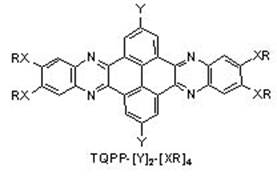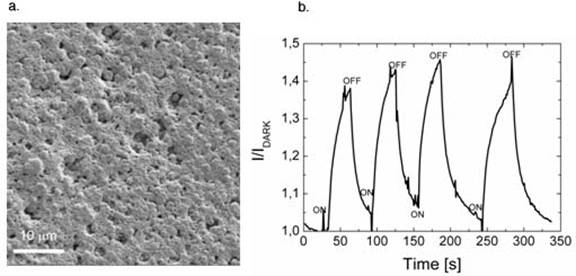AmericanChemicalSociety.com
Reports: B10 47343-B10: Design and Synthesis of Novel Pyrene Discotics and Their Investigation in Organic Photovoltaic Cells
Bilal R. Kaafarani, American University of Beirut
During the second year of this project, we continued exploiting the discoid molecules based on quinoxalino[2',3':9,10]phenanthro[4,5-abc]phenazine TQPP-[Y]2-[XR]4, Figure 1, for potential electronic applications.
The morphological and electrical properties of TQPP-[t-Bu]2-[SC6H13]4 combined with butylamine (BAM)-modified graphene sheets (GSs) were studied. The grafting of the amine onto the graphene sheet plane promotes its compatibility with TQPP-[t-Bu]2-[SC6H13]4, which is soluble in BAM, leading to the preparation of homogeneous films containing exfoliated graphene sheets. This was demonstrated by infrared spectroscopy, field emission electron microscopy, and Raman spectroscopy. The film deposited from the BAM-modified GSs/TQPP-[t-Bu]2-[SC6H13]4 blend showed a photoelectrical response higher than those prepared with neat molecule and GSs/TQPP-[t-Bu]2-[SC6H13]4 blend, respectively (Figure 2).
Figure 1. Chemical Structure of TQPP-[Y]2-[XR]4.
Figure 2. (a) FE-SEM images of BAM-modified GSs/TQPP films. (b) Evolution of the current under light-on and light-off steps (normalized with respect to the dark current) of the BAM-modified GSs/TQPP film
Columnar discotic liquid crystal (DLC) phases of conjugated compounds are useful to align the molecules for improving their charge mobilities. DLCs may form efficient π-π columnar stacks, which permit the achievement of high charge-carrier mobilities, the magnitude of which is fundamentally determined by the degree of order and π-π molecular orbital overlap within the columnar stacks. In our recent report, we reported the absence of mesophase behavior in a series of conjugated compounds, TQPP-[SCnH2n+1]4) (n = 6, 8, 10 and 12), which display p-channel characteristics. The mesophase behavior of TQPP-[t-Bu]2-[OC10H21]4 using DSC, 1D WAXD, 2D WAXD, and PLM showed that this compound possesses a DLC phase, Figure 3.
Figure 3. PLM photo (a) and DSC traces (b) of TQPP-[t-Bu]2-[OC10H21]4.
Furthermore, we have developed a new research project in my group. This includes the design and synthesis of novel based-anion sensors, Figure 4. We investigated the binding studies of two new phenazine sensors with an array of mono- and polyatomic anions using UV–vis, fluorescence, and NMR titrations. Binding constants were calculated for anions, which exhibited high affinity for the sensors, including acetate, benzoate, cyanide, and fluoride ions.
Figure 4. Fluorescence of 1 and 2 in presence of different anions.
Copyright © American Chemical Society





